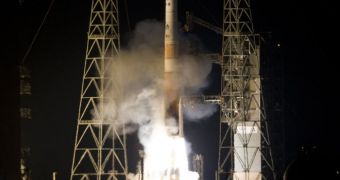As part of its ongoing effort to improve weather predictions across the United States, the American space agency has yesterday evening launched its latest in a series of high-tech weather satellites. The GOES-P spacecraft took off from Space Launch Complex 37 at the Cape Canaveral Air Force Station (CCAFS), in Florida, at 6:57 pm EST (2357 GMT) March 4. It was carried by a United Launch Alliance Delta 4 delivery system, which performed admirably. With the Geostationary Operational Environmental Satellite-P scheduled to begin operations soon, NASA and the US National Oceanic and Atmospheric Administration (NOAA) will provide their country with additional abilities to predict good and bad weather alike, Space reports.
"This satellite is absolutely critical to accurate hurricane forecasting and warnings. We really couldn’t do our job without it and I'm just glad to see we've got another GOES going up,” said before the successful launch Bart Hagemeyer. The expert is the meteorologist in charge of the Forecast Office, at the Melbourne, Florida-based NOAA National Weather Service. “It's a great day for NASA and NOAA, as this last launch completes the spacecraft in the GOES N-P series,” added after take off the deputy manager of the GOES project, Andre Dress. He is based at the NASA Goddard Space Flight Center, in Greenbelt, Maryland.
“It means the hard work and dedication from this team during the past 12-plus years all has been worth it. Our review of the spacecraft and launch vehicle data shows that GOES-P is in a nominal transfer orbit with all spacecraft systems functioning properly,” he added. As soon as the new satellite finishes its test and commissioning phases, NASA will hand over control of the spacecraft to NOAA, which will use GOES-P alongside the other members of the satellite constellation. Initially, the spacecraft was scheduled to launch on Tuesday, March 2, but technical glitches and bad weather thwarted the take-off attempt. Designing and building the instrument took about $500 million.
“This completes the latest satellite in the GOES series to provide continuous weather monitoring for more than 50 percent of the planet. It's fully anticipated that it will last greater than 15 years,” says Charlie Maloney, who is an expert at the El Segundo, California-based Boeing Space and Intelligence Systems. The company was in charge of building GOES-P, and Maloney is the GOES N-P program manager there. “It's all about saving lives and property. That’s one of its primary goals and we don’t take that responsibility lightly,” the official said right before the satellite launched.

 14 DAY TRIAL //
14 DAY TRIAL //